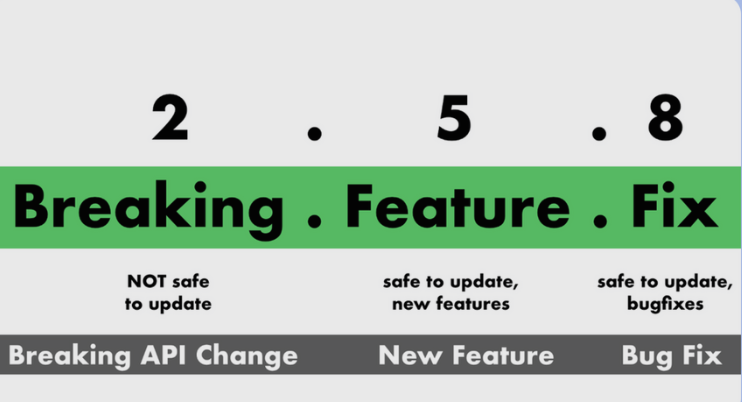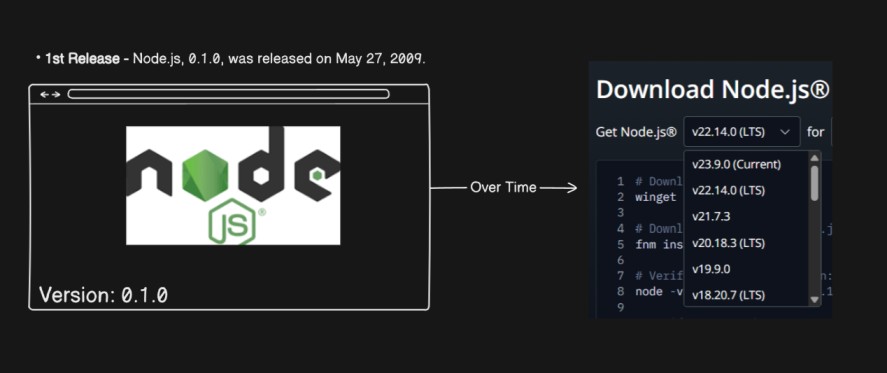Uncovering the Mystery: Why Software Versions Use Numbers Like 1.2.0
 Arzo Raza
Arzo Raza
SemVer(MAJOR.MINOR.PATCH) is the general version standard that is used to know their changes over time. What? let us understand with a Real example:
Imagine you are launching your 1st Software, Hardware, Book, Research paper, etc., and after launch your users demand a new feature or you want to add a new feature or something new updates. Then you start working again and you are still working on the same product for 1 week 2 weeks 6 months to improve your product, once you get a better product from the previous then you again launch in the market. then you need a “Version” for the second launch for you or your user to differentiate the same 1st product or 2nd new product. which is known as MAJOR.MINOR.PATCH (0.0.0)
What does each MAJOR MINOR PATCH mean:
MAJOR (Big changes) – If the first number changes (1.0.0 → 2.0.0), it means the software has big changes that may break old features.
MINOR (New features, no breakage) – If the second number changes (1.2.0 → 1.3.0), new features were added, but everything still works as before.
PATCH (Small fixes) – If the third number changes (1.2.3 → 1.2.4), only small bug fixes are made, and nothing else changes.
Example:
Imagine a messaging app:
Version 1.0.0 – First official release.
Version 1.1.0 – Adds "dark mode" but doesn’t break anything. (MINOR update)
Version 1.1.1 – Fixes a bug where messages weren’t being sent. (PATCH update)
Version 2.0.0 – Changes how messages are stored, so old versions don’t work with this one. (MAJOR update)
Let’s see a real product example.
Node.js Version for the Windows users.

In the above image, you can see the first version of NODE.js was 0.1.0. it was released in 2009. and today as now we have a version of NODE.js 22.14.0 and (LTS) attached for describing a message for the Developer that is (Long Term Support) it’s means it’s a stable version no need to worry about new updates(version).
1 Question: Node.js they updates their products major-22 time, minor-14 time, and patch-0 times?
Nice Question, it does not work like that. But you are on the right track.
v22.14.0(LTS) mean:
22 (MAJOR) → The 22 major versions of Node.js, meaning they have made big changes and may have broken old features since version (v21.7.3)
14 (MINOR) → There have been 14 updates within the 22.x.x series, adding new features but keeping everything compatible.
0 (PATCH) → There have been no bug fixes or security updates after 22.14.0.
Semantic versioning is standard like ECMAScript?
No. That is the reason Here Semantic versioning is available but ChatGPT not using a Semantic version structure.
Why does ChatGPT use names like GPT-3.5, GPT-4, and GPT-4o instead of SemVer?
Marketing & Branding – Numbers like GPT-4 sound more impressive and easier for users to remember than something like 3.5.0.
AI Models Don’t Have "Patches" – Unlike software with small bug fixes, AI models are trained separately. A new version (like GPT-4o) is usually a big upgrade, not just a minor fix.
No Strict API Compatibility – Semantic Versioning is useful for software where developers need to track small changes. AI models, however, don’t follow this structure because they aren't updated in small steps.
Custom Versioning for AI – OpenAI likely follows its own versioning logic, where:
GPT-3.5 means an improved version of GPT-3.
GPT-3.5 Turbo means an optimized and cheaper version of GPT-3.5.
GPT-4 is a major jump in model capability.
GPT-4o (Omni) introduces new enhancements in speed and multimodality.
Why Do Some Software Products Still Use Semantic Versioning?
For most apps, libraries, and APIs, developers need clear updates on what has changed, so MAJOR.MINOR.PATCH is useful.
But for AI models, operating systems (e.g., Windows 10, Windows 11), and some hardware, a more flexible or marketing-friendly versioning method works better.
Conclusion:
Not all products follow Semantic Versioning. OpenAI, Microsoft, Apple, and others often create custom versioning to fit their needs.
Subscribe to my newsletter
Read articles from Arzo Raza directly inside your inbox. Subscribe to the newsletter, and don't miss out.
Written by

Arzo Raza
Arzo Raza
🚀 Tech Enthusiast | Software Developer 💡 Building Solutions, Not Just Code | Learning from Failures 🤖 Passionate About Web Development & AI 🌱 Empowering Growth Through Continuous Learning ✨ Former Intern at Xpediolive Technologies Pvt. Ltd.